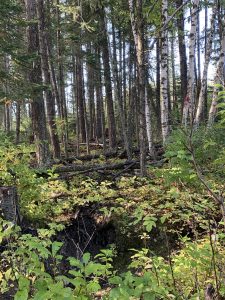Learning recognizes the role of Indigenous knowledge and is experiential.
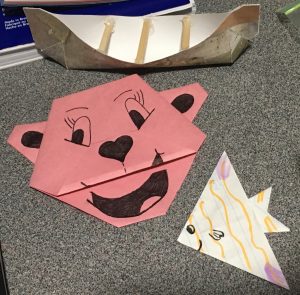 During my first year of the BEd program, I had the opportunity to teach a Grade 4/5 class at Harwin Elementary once a week. I chose to focus on natural resources. We discussed the importance of canoes to Indigenous people and how that was the main source of transportation. We also learned some interesting facts about spirit bears (the bears found in the local Prince George community). We did some fun hands on activities (making a canoe and origami) to tie in the learning.
During my first year of the BEd program, I had the opportunity to teach a Grade 4/5 class at Harwin Elementary once a week. I chose to focus on natural resources. We discussed the importance of canoes to Indigenous people and how that was the main source of transportation. We also learned some interesting facts about spirit bears (the bears found in the local Prince George community). We did some fun hands on activities (making a canoe and origami) to tie in the learning.
Learning is focused on connectedness and a sense of place.
My cohort had the opportunity to explore our very own background at UNBC with Vanessa Elton. The focus was on trees; we learned about the differences between fir, pine, spruce, and cedar. We used our senses to determine the differences. This day consisted of storytelling and truly admiring nature. Being a city girl, I truly appreciated this experience. I will definitely be incorporating similar outdoor lessons within my teaching.
Learning requires exploration of one’s identity.
 I presented on the 3 baskets of knowledge to my fellow teacher candidates. 1) kete-uruuru-matua (peace, goodness, and love) 2) kete-uruurw-rangi (prayers, incantations and ritual) 3) kete-uruuru-tau (knowledge of peaceful arts that promote the welfare of mankind). As an activity, we separated into 3 different groups and each group created one basket. Everyone was asked to write or draw something on a strip that resonated with them regarding that particular basket. At the end, teacher candidates worked together to weave all their strips into a basket. Basket weaving was a great way for everyone to create a physical and emotional connection to the 3 baskets.
I presented on the 3 baskets of knowledge to my fellow teacher candidates. 1) kete-uruuru-matua (peace, goodness, and love) 2) kete-uruurw-rangi (prayers, incantations and ritual) 3) kete-uruuru-tau (knowledge of peaceful arts that promote the welfare of mankind). As an activity, we separated into 3 different groups and each group created one basket. Everyone was asked to write or draw something on a strip that resonated with them regarding that particular basket. At the end, teacher candidates worked together to weave all their strips into a basket. Basket weaving was a great way for everyone to create a physical and emotional connection to the 3 baskets.
Learning is embedded in memory, history, and story.
 I did a storytelling presentation with a few of my classmates. Storytelling is one of the First Peoples Principles of Learning and is an important component to Indigenous cultures. Our group presented on the Ramayana which is an ancient story originating from India in 500 B.C.E. I grew up with this story as it reflects a popular festival that my family celebrates, Diwali.
I did a storytelling presentation with a few of my classmates. Storytelling is one of the First Peoples Principles of Learning and is an important component to Indigenous cultures. Our group presented on the Ramayana which is an ancient story originating from India in 500 B.C.E. I grew up with this story as it reflects a popular festival that my family celebrates, Diwali.
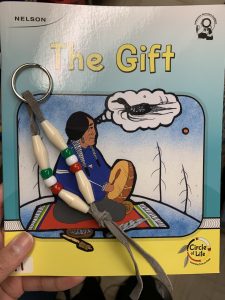 During my practicum, I read an Indigenous story to the class. The goal of this lesson was for students to share a personal connection to a cultural story. There were parts of the story that a lot of students connected with such as fishing. We would stop throughout the story to have mini class discussions. Students also created key chains afterwards which symbolized a “gift” from the story. We used leather strings and beads to create the key chains.
During my practicum, I read an Indigenous story to the class. The goal of this lesson was for students to share a personal connection to a cultural story. There were parts of the story that a lot of students connected with such as fishing. We would stop throughout the story to have mini class discussions. Students also created key chains afterwards which symbolized a “gift” from the story. We used leather strings and beads to create the key chains.
Learning is holistic, reflexive, reflective, experiential, and relational.
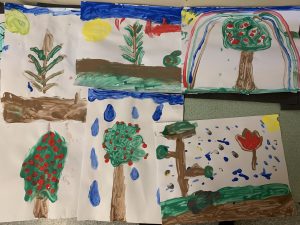 During my practicum, I did a nature walk with the class where we focused on being present in nature. Students used their 5 senses in order to connect with nature. By going on a nature walk, students connected with the land and created their own sense of place. Afterwards, students created a q tip painting reflecting one thing that they connected with while being outside.
During my practicum, I did a nature walk with the class where we focused on being present in nature. Students used their 5 senses in order to connect with nature. By going on a nature walk, students connected with the land and created their own sense of place. Afterwards, students created a q tip painting reflecting one thing that they connected with while being outside.
Learning ultimately supports the well-being of the self, the family, the community, and the land.
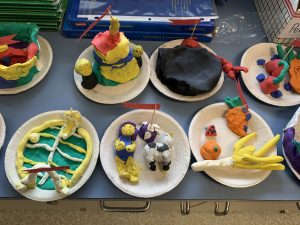 During my practicum, we learned about rights and responsibilities. Students shared the rights and responsibilities that they have at home, at school, and i the community. For their final projects, students created their own lands with modelling clay where they created a representation of a right and a responsibility that is important to them.
During my practicum, we learned about rights and responsibilities. Students shared the rights and responsibilities that they have at home, at school, and i the community. For their final projects, students created their own lands with modelling clay where they created a representation of a right and a responsibility that is important to them.

